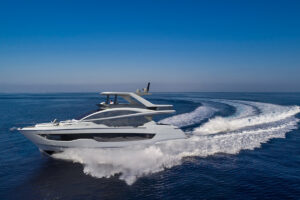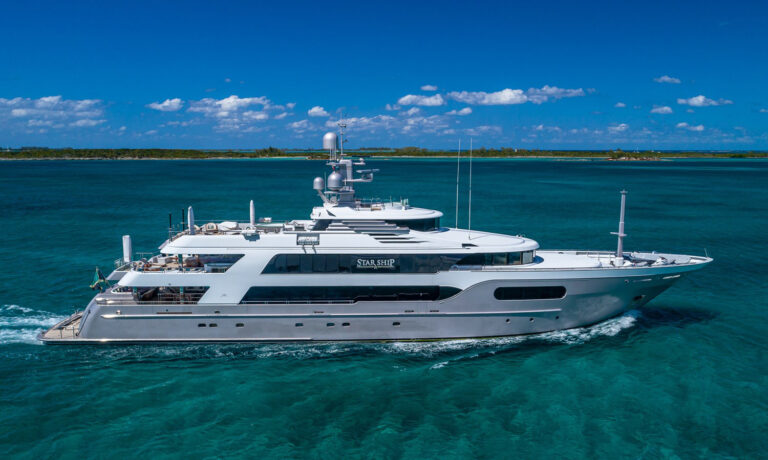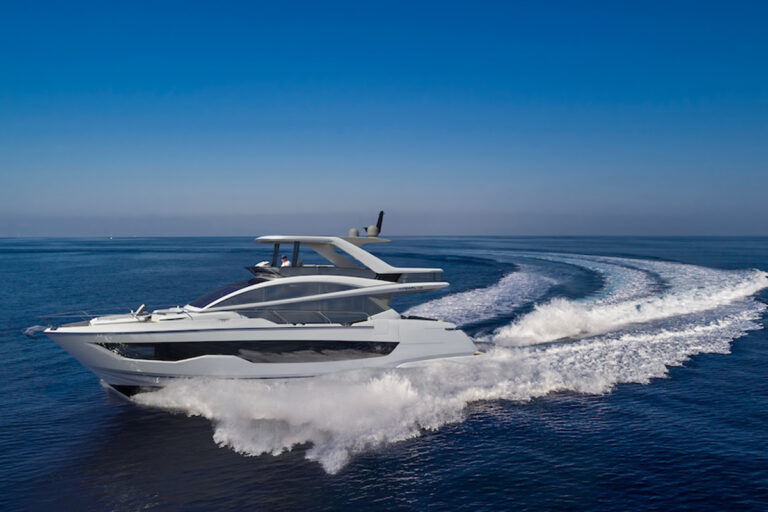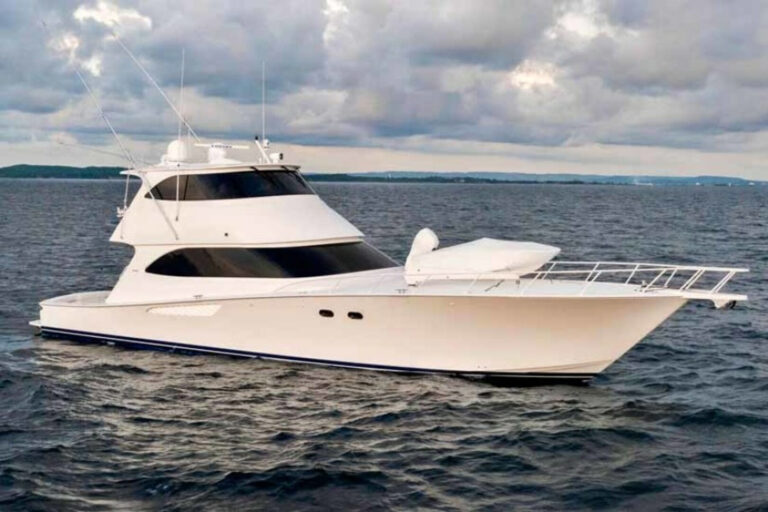The current boat market sports several distinct takes on the raised-pilothouse motoryacht. Some are stalwart, full-displacement battleships designed to head around the globe, while others are better suited for fast tracks along the coast and the occasional jaunt through the islands. And there are even a few Euro-style designs picking up on the advantages of the theme, blending a little salt with some style.
Marlow Marine appears to have approached the raised-pilothouse trend with an á la carte sensibility, borrowing elements from different styles and creating its own variation of the theme. Moreover, the company set out to build each Marlow with high-tech techniques and materials, creating a hybrid a little different from some of the other offerings in this crowded field. The combination results in a magical cruiser.
The introduction of the 57 follows a deliberate path developed by David Marlow, the man behind the curtain. He first introduced the Explorer 65, then expanded the line to include a 61, 70, 72 and 78. (The 78 is scheduled to launch late next year.) Thanks to strong initial interest in the 57, Marlow actually intended to build her before some of the larger models. Marlow’s backlog, however, was large enough that it would not make sound fiscal sense to start building the smaller sister. A second factory came on line a year ago, however, allowing the yard to increase production and broaden the variety of products in its range.
To fully appreciate a Marlow Explorer you need to spend some time with David Marlow. What quickly became apparent during the day-and-a-half I spent with him was that there is not one area aboard the 57-or any of his boats-with which he is unfamiliar. In fact, it doesn’t matter if the item is as minor as a drawer pull or as significant as the engine package; Marlow can tell you the story of why he specified that piece of equipment.
One of the biggest stories is about the 57’s construction. The company specified Kevlar for the hull fabric because of its durability and lightness. Though a host of quality raised-pilothouse builds are coming out of the Far East, Marlow is one of the few using high-tech techniques. For instance, vinylester resin and closed-cell foam is vacuum-bagged to help keep weight in check and eliminate voids. Structural bulkheads, and the saloon and lower soles, are a foam/fiberglass combination. Marlow then vacuum-bags the assembly. By keeping wood out of the sole, weight and maintenance are reduced. Furthermore, the increased strength negates the need for an overabundance of structural beams, creating more space and flexibility on the lower deck and in the engineroom.
Like all Marlows, the 57 is semi-custom. Though she has a standard layout, Marlow works with buyers, for a reasonable up-charge, to make changes. Except for the hull and superstructure, no two yachts have been alike. All the Explorers I’ve been on, however, share the same high standard of workmanship and finish quality.
“Maybe they think I’m crazy”, said Marlow, referring to the workers on his factory floor in Taiwan. “But now they also have the same mindset and are bringing ideas to me, so each boat is better than the one before.” For instance, Marlow buys his own teak and personally inspects each log before it goes into a new Explorer. As I walked through the saloon on the 57, this attention was evident. The teak is smooth and blended into a uniformity that is tough to match. A solid teak sole is a nice change compared with thin veneers. This treatment should prove the better choice 10 years from now. Even the inside of each drawer is well finished and dovetailed.
“They wanted dragons; I wanted little details”, said Marlow, recalling the initial building stage of the first Explorer 65 several years ago.
The owners of our test boat, aptly named Charmer, chose tropical Tommy Bahama-type accents to complement the woodwork. There is plenty of space to plop down with the morning paper thanks to an L-shape settee on the starboard side and a straight settee on the port side. Being perhaps a little too pragmatic, I prefer this arrangement rather than a settee opposite two barrel chairs. You gain a better place to sit while at sea and another for stretching out while in port.
It’s abundantly clear that this yacht is not intended to collect barnacles while doing time as a waterside condo. This is a cruising boat. (After our test, the owners set out for a few weeks in the Bahamas.) Details such as conveniently placed grab rails for use while under way, drawers with positive latches to keep them closed at sea, and proper night lighting all make a difference when cruising. The attention to the systems follows the same thinking. A small sampling of the extensive standard-equipment list includes a split freshwater system with a tap for drinking water, drawn from a polished stainless-steel tank and one for domestic use, dual 50-gallon water heaters, two Glendinning Cablemasters, a washer and dryer, and reverse-cycle air conditioning.
The pilothouse, like many raised-pilothouse designs, has the necessary cruising yacht appointments and the comforts of home. The layout of the U-shape galley, abaft the helm, offers a great working area, providing enough counter space to prepare a Thanksgiving feast. On long passages aboard similar boats, I’ve found myself cooking a big breakfast in the pilothouse area but still keeping an eye on the radar and the ocean ahead of me.
A single Stidd seat serves the helm station and should be a comfortable spot to run the 57 on a long leg. I would prefer two helm seats, but the portside dinette is elevated, so you can sit and see out through the front windows. Below the helm is a huge space for servicing the electronics.
The lower deck features a layout fairly typical of a 57-foot raised-pilothouse design. It includes the master stateroom amidships with a centerline king berth and an en suite head that benefits from streams of natural light. A portside stateroom and a forward stateroom share a head. Pulling up a few floorboards revealed more hidden treasures. The beautifully finished bilge has active and passive ventilation, resulting in continuous airflow through the boat, helping to keep things fresh. Under the forward berth, a self-contained box houses the anchor chain. In order to keep weight out of the bow, Marlow designed a system that places the chain about 13 feet abaft the stem. Looking to build a better mousetrap, he also designed the system to automatically spray salt water inside the chain pipe while the windlass brings up the chain.
It seemed appropriate that I began my walk-through in the 57’s well-appointed engineroom. Access is from a door in the covered afterdeck, which brings you into the crew quarters abaft the engineroom. A second, dogged hatch goes through the saloon sole. Getting around the 700 hp Caterpillar C12 diesels is painless thanks to well-placed grab rails, non-skid platforms for a safe step over the shafts and plenty of space between the engines and the hull. The reflection of the bright 24- and 110-volt lighting glows in the engineroom’s Awlgrip finish.
Fuel tanks, placed across the forward engineroom bulkhead, benefit from a well-labeled manifold. Better yet, you can use most of the boat’s fuel, since the bottom of the tank follows the slope of the hull to a sump. The result is that all but 20 gallons of the 1,400-gallon capacity can be used, according to David Marlow. The tanks include large inspection plates for cleaning.
Our sea trial revealed a slippery hull with an easy motion. This was no demo boat stripped down to gain a few extra knots. She was loaded with owner’s gear and stores for a Bahamian cruise and topped off with full fuel and water. We achieved a top speed of 20.9 knots at 2300 rpm, which David found disappointing. Before leaving, he mentioned that the yard was still tweaking the boat. In fact, we booted a Caterpillar mechanic off the boat before our test. When we returned, he discovered a boost sensor issue. This was fixed, and Charmer reached a top speed of 22.2 knots, according to Marlow.
Marlow Marine, with assistance from yacht designer Doug Zurn, spiced up the typical semi-displacement hull form by incorporating twin strut keels just forward of the propeller pockets, offering good protection of the wheels. In addition, as was proven during our sea trial, they appear to reduce rolling motion and pitch. And I didn’t touch the tabs, another feature I attributed to the extra lift from the strut keels.
This article started out as a four-page feature, then grew to five pages and is now six. Still, a number of great things about the Marlow Explorer 57 remain unmentioned. She is a yacht that deserves the time of prospective buyers. Better yet, they should spend time with David Marlow and his staff, learning all they can about the other few hundred stories behind the magic.
Contact: Marlow Marine Sales, (800) 362-2657; sales@marlowmarine.com; www.marlowmarine.com. West Coast dealer: Venwest Yachts, (206) 682-9065; www.venwestyachts.com.









